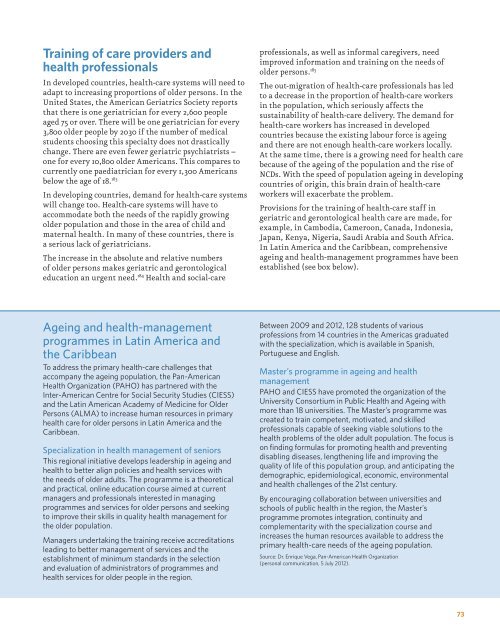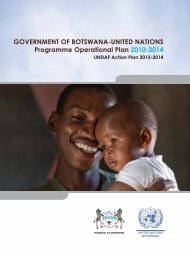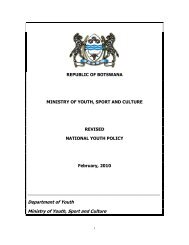Ageing in the Twenty-First Century: - HelpAge International
Ageing in the Twenty-First Century: - HelpAge International
Ageing in the Twenty-First Century: - HelpAge International
You also want an ePaper? Increase the reach of your titles
YUMPU automatically turns print PDFs into web optimized ePapers that Google loves.
Tra<strong>in</strong><strong>in</strong>g of care providers and<br />
health professionals<br />
In developed countries, health-care systems will need to<br />
adapt to <strong>in</strong>creas<strong>in</strong>g proportions of older persons. In <strong>the</strong><br />
United States, <strong>the</strong> American Geriatrics Society reports<br />
that <strong>the</strong>re is one geriatrician for every 2,600 people<br />
aged 75 or over. There will be one geriatrician for every<br />
3,800 older people by 2030 if <strong>the</strong> number of medical<br />
students choos<strong>in</strong>g this specialty does not drastically<br />
change. There are even fewer geriatric psychiatrists –<br />
one for every 10,800 older Americans. This compares to<br />
currently one paediatrician for every 1,300 Americans<br />
below <strong>the</strong> age of 18. 183<br />
In develop<strong>in</strong>g countries, demand for health-care systems<br />
will change too. Health-care systems will have to<br />
accommodate both <strong>the</strong> needs of <strong>the</strong> rapidly grow<strong>in</strong>g<br />
older population and those <strong>in</strong> <strong>the</strong> area of child and<br />
maternal health. In many of <strong>the</strong>se countries, <strong>the</strong>re is<br />
a serious lack of geriatricians.<br />
The <strong>in</strong>crease <strong>in</strong> <strong>the</strong> absolute and relative numbers<br />
of older persons makes geriatric and gerontological<br />
education an urgent need. 184 Health and social-care<br />
professionals, as well as <strong>in</strong>formal caregivers, need<br />
improved <strong>in</strong>formation and tra<strong>in</strong><strong>in</strong>g on <strong>the</strong> needs of<br />
older persons. 185<br />
The out-migration of health-care professionals has led<br />
to a decrease <strong>in</strong> <strong>the</strong> proportion of health-care workers<br />
<strong>in</strong> <strong>the</strong> population, which seriously affects <strong>the</strong><br />
susta<strong>in</strong>ability of health-care delivery. The demand for<br />
health-care workers has <strong>in</strong>creased <strong>in</strong> developed<br />
countries because <strong>the</strong> exist<strong>in</strong>g labour force is age<strong>in</strong>g<br />
and <strong>the</strong>re are not enough health-care workers locally.<br />
At <strong>the</strong> same time, <strong>the</strong>re is a grow<strong>in</strong>g need for health care<br />
because of <strong>the</strong> age<strong>in</strong>g of <strong>the</strong> population and <strong>the</strong> rise of<br />
NCDs. With <strong>the</strong> speed of population age<strong>in</strong>g <strong>in</strong> develop<strong>in</strong>g<br />
countries of orig<strong>in</strong>, this bra<strong>in</strong> dra<strong>in</strong> of health-care<br />
workers will exacerbate <strong>the</strong> problem.<br />
Provisions for <strong>the</strong> tra<strong>in</strong><strong>in</strong>g of health-care staff <strong>in</strong><br />
geriatric and gerontological health care are made, for<br />
example, <strong>in</strong> Cambodia, Cameroon, Canada, Indonesia,<br />
Japan, Kenya, Nigeria, Saudi Arabia and South Africa.<br />
In Lat<strong>in</strong> America and <strong>the</strong> Caribbean, comprehensive<br />
age<strong>in</strong>g and health-management programmes have been<br />
established (see box below).<br />
<strong>Age<strong>in</strong>g</strong> and health-management<br />
programmes <strong>in</strong> Lat<strong>in</strong> America and<br />
<strong>the</strong> Caribbean<br />
To address <strong>the</strong> primary health-care challenges that<br />
accompany <strong>the</strong> age<strong>in</strong>g population, <strong>the</strong> Pan-American<br />
Health Organization (PAHO) has partnered with <strong>the</strong><br />
Inter-American Centre for Social Security Studies (CIESS)<br />
and <strong>the</strong> Lat<strong>in</strong> American Academy of Medic<strong>in</strong>e for Older<br />
Persons (ALMA) to <strong>in</strong>crease human resources <strong>in</strong> primary<br />
health care for older persons <strong>in</strong> Lat<strong>in</strong> America and <strong>the</strong><br />
Caribbean.<br />
Specialization <strong>in</strong> health management of seniors<br />
This regional <strong>in</strong>itiative develops leadership <strong>in</strong> age<strong>in</strong>g and<br />
health to better align policies and health services with<br />
<strong>the</strong> needs of older adults. The programme is a <strong>the</strong>oretical<br />
and practical, onl<strong>in</strong>e education course aimed at current<br />
managers and professionals <strong>in</strong>terested <strong>in</strong> manag<strong>in</strong>g<br />
programmes and services for older persons and seek<strong>in</strong>g<br />
to improve <strong>the</strong>ir skills <strong>in</strong> quality health management for<br />
<strong>the</strong> older population.<br />
Managers undertak<strong>in</strong>g <strong>the</strong> tra<strong>in</strong><strong>in</strong>g receive accreditations<br />
lead<strong>in</strong>g to better management of services and <strong>the</strong><br />
establishment of m<strong>in</strong>imum standards <strong>in</strong> <strong>the</strong> selection<br />
and evaluation of adm<strong>in</strong>istrators of programmes and<br />
health services for older people <strong>in</strong> <strong>the</strong> region.<br />
Between 2009 and 2012, 128 students of various<br />
professions from 14 countries <strong>in</strong> <strong>the</strong> Americas graduated<br />
with <strong>the</strong> specialization, which is available <strong>in</strong> Spanish,<br />
Portuguese and English.<br />
Master’s programme <strong>in</strong> age<strong>in</strong>g and health<br />
management<br />
PAHO and CIESS have promoted <strong>the</strong> organization of <strong>the</strong><br />
University Consortium <strong>in</strong> Public Health and <strong>Age<strong>in</strong>g</strong> with<br />
more than 18 universities. The Master’s programme was<br />
created to tra<strong>in</strong> competent, motivated, and skilled<br />
professionals capable of seek<strong>in</strong>g viable solutions to <strong>the</strong><br />
health problems of <strong>the</strong> older adult population. The focus is<br />
on f<strong>in</strong>d<strong>in</strong>g formulas for promot<strong>in</strong>g health and prevent<strong>in</strong>g<br />
disabl<strong>in</strong>g diseases, leng<strong>the</strong>n<strong>in</strong>g life and improv<strong>in</strong>g <strong>the</strong><br />
quality of life of this population group, and anticipat<strong>in</strong>g <strong>the</strong><br />
demographic, epidemiological, economic, environmental<br />
and health challenges of <strong>the</strong> 21st century.<br />
By encourag<strong>in</strong>g collaboration between universities and<br />
schools of public health <strong>in</strong> <strong>the</strong> region, <strong>the</strong> Master’s<br />
programme promotes <strong>in</strong>tegration, cont<strong>in</strong>uity and<br />
complementarity with <strong>the</strong> specialization course and<br />
<strong>in</strong>creases <strong>the</strong> human resources available to address <strong>the</strong><br />
primary health-care needs of <strong>the</strong> age<strong>in</strong>g population.<br />
Source: Dr. Enrique Vega, Pan-American Health Organization<br />
(personal communication, 5 July 2012).<br />
73







